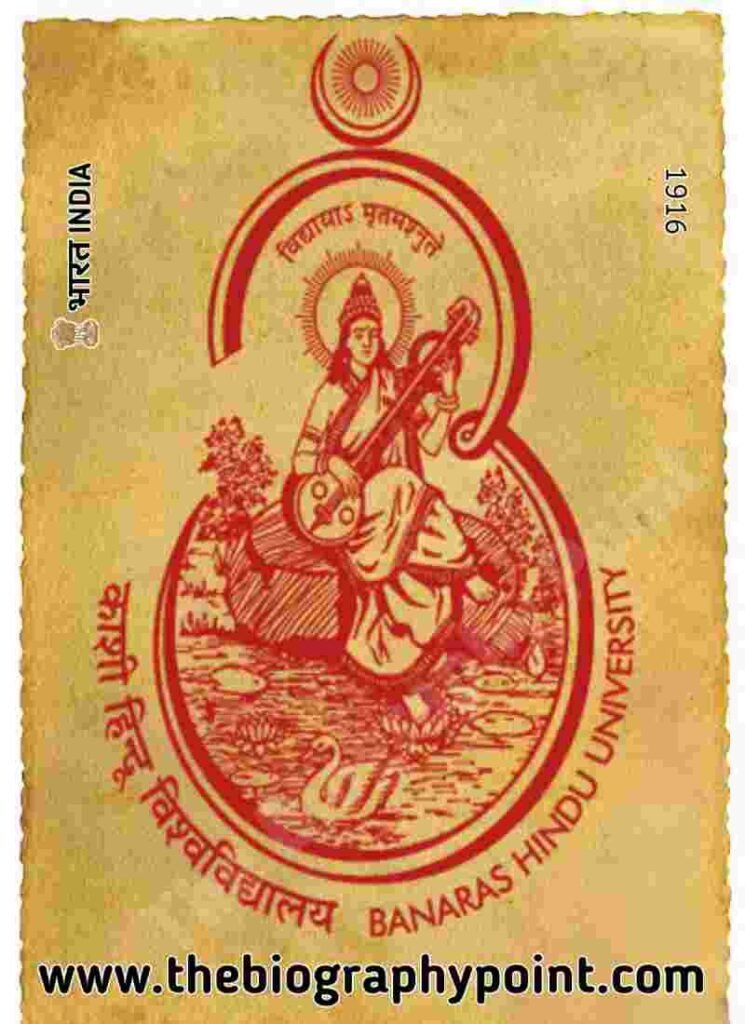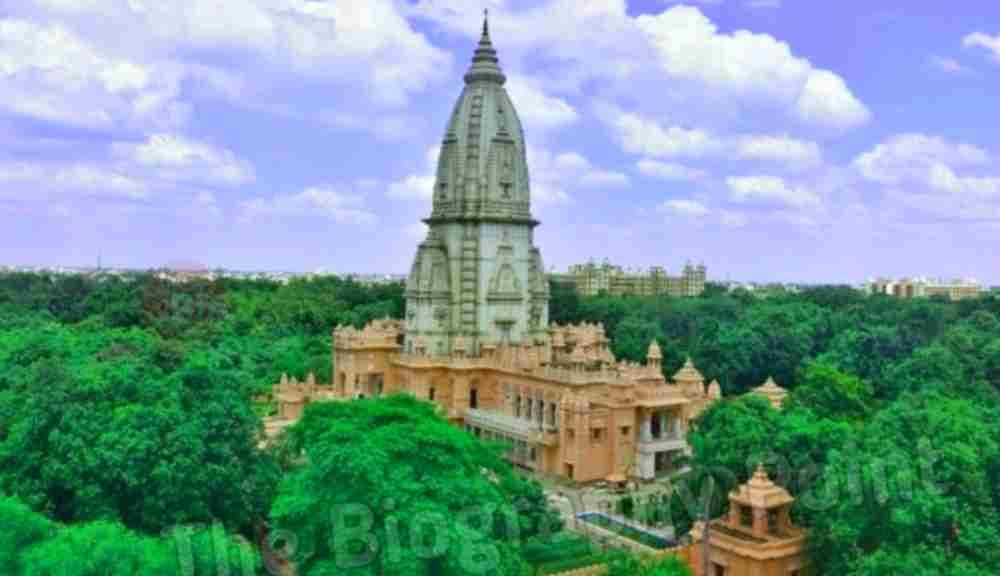| Full Name | Banaras Hindu University |
| Other Name | BHU |
| Establishment | February 4, 1916 |
| Age | 108 Years |
| Campus | 1370 acres (Urban Place) |
| BHU Total Seats | 30698 Students |
| Location | BHU, Varanasi, Uttar Pradesh (India) |
| Academic Affiliations | • Association of Indian Universities, • University Grants Commission, • Indian Council of Agricultural Research |
| Type | Public Research University |
| Launguage | Sanskrit, Hindi and English |
| Moscot | Goddess Saraswati |
| Founders | • Madan Mohan Malaviya • Annie Besant • Rameshwar Singh • Prabhu Narayan Singh • Sunder Lal |
| Website: | https://www.bhu.ac.in/ |
| Jane Austen Biography | Novelist | Click Here |
| Abhishek Sharma Biography: Cricketer | Click Here |

BHU Biography In English
Introduction
Banaras Hindu University (BHU) is a very important school in India. It is in Varanasi, Uttar Pradesh. In 1916, a leader named Pandit Madan Mohan Malaviya founded BHU. It has a strong history of being really good at school, doing research, and preserving culture. The university has a really big campus that covers over 1,300 acres. It’s one of the biggest residential universities in Asia. BHU has many different courses and research projects, and it helps Indian society.
Founding and Early Years
Pandit Madan Mohan Malaviya, who was a respected teacher and fighter for freedom, came up with the idea for BHU. He wanted the university to have the good parts of both Indian and Western education. He wanted to build a place that would make people proud of India and help the country grow socially and economically. With the help of rich and generous people, the foundation stone of BHU was laid on February 4, 1916.
The university was made to help people learn about lots of different things like science, engineering, medicine, and the humanities. It also wants to keep India’s cultural traditions alive. BHU’s motto “Knowledge imparts immortality” shows the university’s dedication to seeking knowledge and wisdom.
Campus and buildings
Campus: The BHU campus spans over 1,370 acres and is divided into two main areas: the main campus and the South campus. The main campus is home to the central library, numerous faculties, hostels, and the famous Bharat Kala Bhavan museum. The South campus, also known as the Rajiv Gandhi South Campus, is located in Barkachha, Mirzapur district, and focuses on rural development and agricultural studies.

BHU is a big campus on the side of the River Ganges. It is made to be a town that has everything students need for education. The campus is split into different parts, each one focused on a specific area of study. The campus has a lot of academic buildings, libraries, hostels, apartments, auditoriums, and sports facilities and is really green and pretty.
The Central Library, also called Sayaji Rao Gaekwad Library, is really big and has a lot of books, journals, and digital stuff. It’s one of the biggest in Asia. The library is an important place for students and researchers. They can find lots of information in many different subjects there.
Academic Structure
BHU offers a wide range of undergraduate, postgraduate, and doctoral programs across multiple disciplines. The university’s academic structure is organized into six institutes:
- Institute of Science: Offers programs in physical, chemical, biological, and earth sciences.
- Institute of Agricultural Sciences: Focuses on agricultural education, research, and extension.
- Institute of Medical Sciences: Comprises the Faculty of Medicine, Faculty of Dental Sciences, and Faculty of Ayurveda.
- Institute of Technology: Provides engineering and technological education and research.
- Institute of Environment and Sustainable Development: Focuses on sustainable development and environmental studies.
- Institute of Management Studies: Offers management education and research programs.
In addition to these institutes, BHU has several faculties, including the Faculty of Arts, Faculty of Social Sciences, Faculty of Law, Faculty of Performing Arts, and Faculty of Visual Arts, among others. Each faculty is further divided into departments specializing in specific areas of study.
Research and Innovation
BHU focuses a lot on research and coming up with new ideas. They have lots of research centers and labs that work on learning more about different subjects. The university wants researchers to work together across different subjects and with other institutions in the country and around the world. BHU’s research has helped a lot in making new discoveries in science, technology, and society.
Some important research centers at BHU are:
- DST Centre for Interdisciplinary Mathematical Sciences (CIMS): Focuses on mathematical sciences research.
- Interdisciplinary School of Life Sciences (ISLS): Promotes research in life sciences and biotechnology.
- Centre for Genetic Disorders: Conducts research on genetic disorders and related fields.
- Malaviya Centre for Peace Research (MCPR): Dedicated to peace studies and conflict resolution.
BHU’s researchers have made significant contributions in fields such as physics, chemistry, biology, medicine, agriculture, and environmental science. The university also collaborates with industries and government agencies to translate research findings into practical applications.
Cultural and Extracurricular Activities
Cultural and after-school activitiesBHU has a lively cultural scene and wants students to join in lots of fun activities outside of class. The university holds many different cultural events, sports games, and academic competitions all year long. These activities let students show their skills, learn how to lead, and feel like they belong in a group.
At BHU, some popular activities include cultural events and clubs.
- Spandan: The annual cultural festival that features music, dance, drama, and literary events.
- Athletic Meet: A major sports event that includes track and field competitions, team sports, and other athletic activities.
- NSS and NCC: National Service Scheme (NSS) and National Cadet Corps (NCC) units at BHU promote social service, discipline, and community engagement among students.
BHU also has numerous student clubs and societies dedicated to various interests, such as debating, music, theater, photography, and entrepreneurship. These clubs provide a platform for students to pursue their passions and develop new skills.
Famous Graduates
BHU has helped many former students who have done important things in different areas like politics, science, arts, literature, and business. Some famous people who graduated from BHU are:
- Dr. Sarvepalli Radhakrishnan: Philosopher, statesman, and the second President of India.
- Harivansh Rai Bachchan: Renowned Hindi poet and writer.
- C. N. R. Rao: Eminent scientist and recipient of the Bharat Ratna.
- M. S. Swaminathan: Agricultural scientist known as the father of the Green Revolution in India.
- K. N. Udupa: Pioneer in the field of integrative medicine.
These former students have made BHU proud with their accomplishments and have shown future students how to succeed.
Social Impact and Community Engagement
BHU really cares about helping people and being involved in the community. The university has many programs to help people in nearby areas have better lives. These programs provide medical care, help with school, and improve rural areas.
The Sir Sunderlal Hospital at BHU helps people in the area with all their healthcare needs. The hospital has the newest medical tools and is a place where medical students can learn.
BHU helps farmers in the area by providing training and support through its Institute of Agricultural Sciences. These projects are trying to encourage farming in a way that helps the environment and makes life better for people who live in the countryside.
Challenges and Future Directions
Despite its many achievements, BHU faces several challenges as it continues to evolve in the 21st century. Some of these challenges include:
- Infrastructure Development: Ensuring that the university’s infrastructure keeps pace with the growing student population and advancements in technology.
- Research Funding: Securing adequate funding for research projects and attracting top talent to drive innovation.
- Quality of Education: Maintaining high standards of education and adapting to changing educational paradigms.
- Social Inclusivity: Promoting diversity and inclusivity within the university community.
To address these challenges, BHU has undertaken several initiatives aimed at strengthening its academic and research capabilities. The university is focusing on building state-of-the-art facilities, enhancing industry-academia collaborations, and fostering a culture of excellence and innovation.
Conclusion
Banaras Hindu University stands as a testament to the vision and dedication of its founder, Pandit Madan Mohan Malaviya. Over the years, BHU has grown into a leading center of education, research, and cultural heritage in India. Its contributions to society, coupled with its commitment to academic excellence, have earned it a place of honor in the annals of Indian higher education. As BHU continues to adapt to the changing times, it remains a beacon of knowledge and a source of inspiration for students and scholars around the world.
Frequently Asked Questions (FAQs) About Banaras Hindu University (BHU) Biography:
Q. What is Banaras Hindu University (BHU)?
Ans. BHU is a public central university located in Varanasi, Uttar Pradesh, India. It was founded in 1916 by Pandit Madan Mohan Malaviya.
Q. Who was the founder of BHU?
Ans. Pandit Madan Mohan Malaviya founded BHU in 1916.
Q. What is the motto of BHU?
Ans. The motto of BHU is “Vidyaya Amritam Ashnute” which translates to “Knowledge imparts immortality.”
Q. How many faculties does BHU have?
Ans. BHU has 14 faculties covering a wide range of disciplines.
Q. What are some of the notable faculties at BHU?
Ans. Some notable faculties include the Faculty of Arts, Faculty of Social Sciences, Faculty of Science, Faculty of Law, Faculty of Medicine, and Faculty of Engineering and Technology.
Q. What is the student population at BHU?
Ans. BHU has over 30,000 students enrolled in various undergraduate, postgraduate, and doctoral programs.
Q. Does BHU offer residential facilities?
Ans. Yes, BHU provides residential facilities with numerous hostels for both male and female students.
Q. What is the BHU entrance exam called?
Ans. BHU conducts its own entrance exams called BHU UET (Undergraduate Entrance Test) and BHU PET (Postgraduate Entrance Test).
Q. What are some notable alumni of BHU?
Ans. Notable alumni include former Prime Minister of India Lal Bahadur Shastri, economist Amartya Sen, and actor Manoj Bajpayee.
Q. What is the campus size of BHU?
Ans. The main campus of BHU spans over 1,370 acres in Varanasi.
Q. Does BHU have any affiliated colleges?
Ans. Yes, BHU has several affiliated colleges, including the Institute of Medical Sciences and the Institute of Agricultural Sciences.
Q. What research facilities are available at BHU?
Ans. BHU hosts numerous research centers and institutes, including the Institute of Science and the Institute of Technology.
Q. What international collaborations does BHU have?
Ans. BHU collaborates with various international universities and institutions for research and academic exchange programs.
Q. What cultural activities are prominent at BHU?
Ans. BHU has a vibrant cultural scene with events like Spandan, cultural festivals, and various student organizations and clubs.
Q. What sports facilities does BHU offer?
Ans. BHU offers extensive sports facilities, including grounds for cricket, football, and hockey, as well as courts for tennis, badminton, and basketball.
Q. How can one apply for admission to BHU?
Ans. Admissions to BHU are primarily based on entrance exams (BHU UET/PET) and merit-based selection processes.
Q. Does BHU have a medical college?
Ans. Yes, BHU has a well-known medical college, the Institute of Medical Sciences.
Q. What kind of financial aid is available at BHU?
Ans. BHU offers various scholarships, fellowships, and financial assistance programs to deserving students.
Q. Is BHU involved in community service?
Ans. Yes, BHU is actively involved in community service through its various outreach programs and social initiatives.
Q. What is the official website of BHU?
Ans. The official website of BHU is www.bhu.ac.in.











